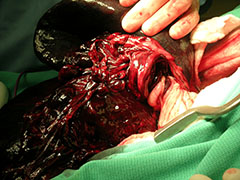Splenic torsion occurs when the blood supply to the spleen twists on itself (Figure 1). This prevents blood drainage, causing subsequent enlargement of the spleen. It occurs most often with gastric dilatation-volvulus (GDV). but can also occur in isolation. Large and giant breed dogs with a deep-chested conformation (e.g., Great Danes and German Shepherds) are most commonly affected.
Splenic torsion can be an acute (sudden) condition with signs of pain and collapse or it may be more chronic and your pet may experience non-specific signs such as:
- intermittent abdominal pain
- vomiting
- inappetence
- abdominal distension
- weight loss
- excessive drinking and urination
Abdominal radiographs and ultrasound are useful in confirming the diagnosis of splenic torsion. Other tests that may be required include blood work and urine analysis. In certain cases, an exploratory surgery may be required to obtain definitive diagnosis.

Your pet will be stabilized prior to surgery with fluid therapy and blood products if necessary. Surgical removal of the spleen (splenectomy) is the most commonly performed procedure to correct the torsion. Other treatments may be necessary at the discretion of the doctor before and after surgery. (Figure 1).
Your dog will need restricted activity for two weeks following surgery. Your dog may need to wear an E-collar or t-shirt to prevent self-trauma to the surgical site. Complications from surgery may include cardiac arrhythmias (abnormal heart rhythms), ongoing bleeding, pancreatitis, and infection. Overall the prognosis is good with a normal quality of life expected following full recovery.












